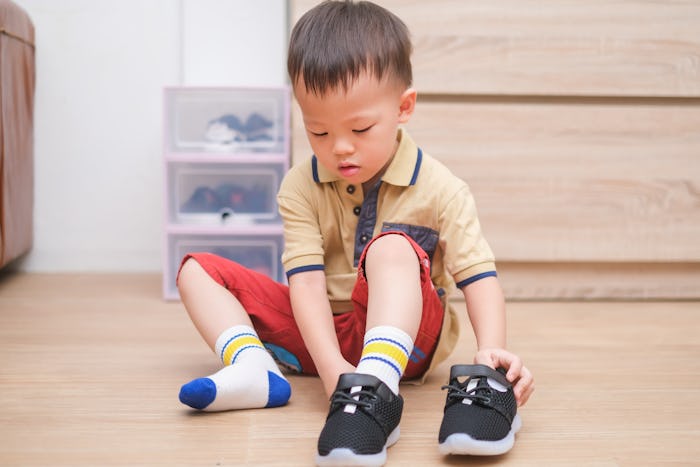Life

Podiatrists Say To Stop Putting These Kinds Of Shoes On Your Toddlers’ Feet
Is there anything cuter than tiny shoes? Maybe your little skater boy is ready to rock Vans or your little USA women’s soccer fan is asking for her own mini sneakers. But, there are some shoes for toddlers’ feet that podiatrists warn about, no matter how darling they look.
Miguel Cunha, DPM, podiatrist at Gotham Footcare in Manhattan, tells Romper that children’s anatomy and development determines when they should begin wearing shoes at all. “With children, their bones aren’t fused in the early stages of development and they fuse as the child starts to grow. Before they’re ambulatory, children start to walk anywhere from 9 months, typically at a year, and some a little bit later at a year and a half,” he explains. “Before then you can have something soft, and once they start ambulating, you would want a hard sole because you want to support their feet or help avoid them injuring their feet.”
When toddlers are ready to start wearing shoes, it’s important for parents to put function before fashion, no matter how adorable those tiny Jellies sandals are. In fact, you may not even need shoes for certain situations. “There are advantages to walking barefoot on carpet, grass, mats, or even walking in the sand, which can help strengthen the musculature of the foot, but definitely not on hard floors because the bones aren’t developed yet," Cunha says. "You want to provide support so the bones can start fusing in a healthy position." Cunha also notes that you want your baby's foot to fuse in an arch, so if your baby has a genetic predisposition to flat feet, walking on hard floors could exacerbate some of those problems if there's not adequate support.
Hard-soled shoes with rubber or leather soles not only provide support, but can help avoid slips and tumbles thanks to their grip, per WebMD. The site also recommends sneakers over boots or sandals because they don’t constrain the feet and ankles, but also offer more support and mold to the child’s feet.
“The best type of shoe is going to be a sneaker, because it’s designed to have support high up in the foot, and it has a rubber sole with traction to avoid injuries,” says Cunha. “If you were to compare flip flops, if it’s summer and the child is doing summer activities, I would recommend more of a sporty sandal. They’re a better alternative summer shoe to provide the same protection, but with ventilation, and usually they have an antibacterial foot bed to avoid odor and keep the foot comfortable and dry.”
Speaking of flip flops, it’s one of the shoe styles Cunha recommends all parents steer clear of when shoe shopping for their young children. “They’re great for convenience and going from a pool to the car, but because they lack arch support and your toes have to grip the flip flop, your foot is supporting the flip flop and not the other way around. You should minimize the use of flip flops because if they have a genetic predisposition to developing hammertoes as they age, it can accelerate those deformities.”
Another example of a major child footwear no-no: heels. Yes, high heels. “Seeing daughters in heels at child pageants — heels are the worst. They are altering the position of the foot in ways that will create tightness in the Achilles tendon and complications as they start to grow. You want to avoid altering the natural mechanics of the body when it’s developing and in a vulnerable state,” Cunha explains.
Lastly, Cunha says most children’s feet grow an average of two sizes per year until age 4, and one size every year after that. Parents should be prepared to go shoe shopping pretty regularly, but know that expensive shoes aren’t necessary. It’s more important to choose supportive, safe shoes that fit well.
“Consider that if the shoe is worn out before those two times of year, you may need new shoes,” he says. “You want to put your pinky finger between your child’s heel and the heel of the shoe, and also do the same with a thumb from the toe to the end of the shoe. Have the child try the shoe on with socks and walk about the store for a few minutes. I don’t like the idea of breaking in shoes, so when the child removes the shoe, look for any red marks on the skin as a sign of rubbing or ill-fitting shoes.”
This article was originally published on